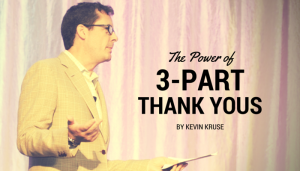
This article was originally published on Forbes.
“Thanks,” Bill said as he walked by, rapping his knuckles on the top of my cube wall.
“See you tomorrow,” I glanced at my watch. Every day, at exactly 5:01, my boss left for the day, saying thanks as he walked past my cube.
At the time, I was working as a “secretary.” I was a 23-year old guy working alongside a dozen single women who were in their thirties, all of us in the role of secretary. I had been placed there by a temporary agency when they discovered I could type 80-words per minute. (It was about 25 years ago so I think we were still called “secretaries” and not “administrative assistants” but I don’t really remember. I do remember that it was a very fun year.)
My boss, Bill, was a creature of habit. At 5:00 PM exactly, he would pop up from his desk, slide on his jacket, grab his briefcase and head for the exit. But without fail, he always thanked me on the way out.
I like to call that a “drive-by thank you”. Better than nothing, but it’s impact waned as I quickly learned it was just something he said on autopilot.
Later, as an entrepreneur and a manager, I saw that recognition works almost like a magic spell. It’s one of the top three drivers of employee engagement.
And as a father, I learned that recognition works magic on kids from the time they are toddlers right through teen years. While there is a time for reprimand, I’ve found liberal use of recognition is a far better behavior changer.
I talk about having an “attitude of gratitude” so often that my daughter Natalie openly mocks me for it. I love that, too. Means she’s listening.
However, thank-you’s are only powerful if we feel they are sincere, thoughtful and specific. I like to give three-part thank-you’s. It’s a simple formula to make the most of them:
- Actually say “thanks” or “thank you”—don’t assume someone will “get it” or “know” you are grateful.
- Mention the behavior or achievement you are grateful for. This is the thing you want more of. This is the thing you want others to know gets rewarded.
- Link it to a value or to a strategic initiative.
For example,
“Hey everybody, before we begin our status meeting I just want to say…Vanessa, thank you for coming in last weekend to debug the reports module. It was a real sign of your dedication to teamwork and to hitting our original ship date. We really appreciate it.”
If this seems a bit contrived, know that it’s no different than how we were taught to have good manners when growing up. How do you write a thank you note to Aunt Ida for your 13th birthday present? Say thanks, mention the gift, and how you will use it or why you like it so much.
“Aunt Ida, thank you for the white tube socks. I’m really going to enjoy having warm non-threatening feet.”
Want your teenage children to suddenly do more of the right thing? First, don’t take them for granted, and use a three-part thank you to reinforce the behaviors you want more of. For example,
“Owen, thank you for taking out the garbage when you got home from school. It shows how responsible you are, and it really helps me to feel less stressed when I walk in from work.”
Whether you’re giving thanks around the Thanksgiving table, trying to drive emotional commitment at work, or navigating relationships with your young kids, a three-part sincere thank-you is noticed and touches people’s hearts.
Thanks for reading and sharing this article; as an author nothing feels better than knowing that my words have made an impact on others.
—
Kevin Kruse is the author of Employee Engagement 2.0: How To Motivate Your Team For High Performance.





